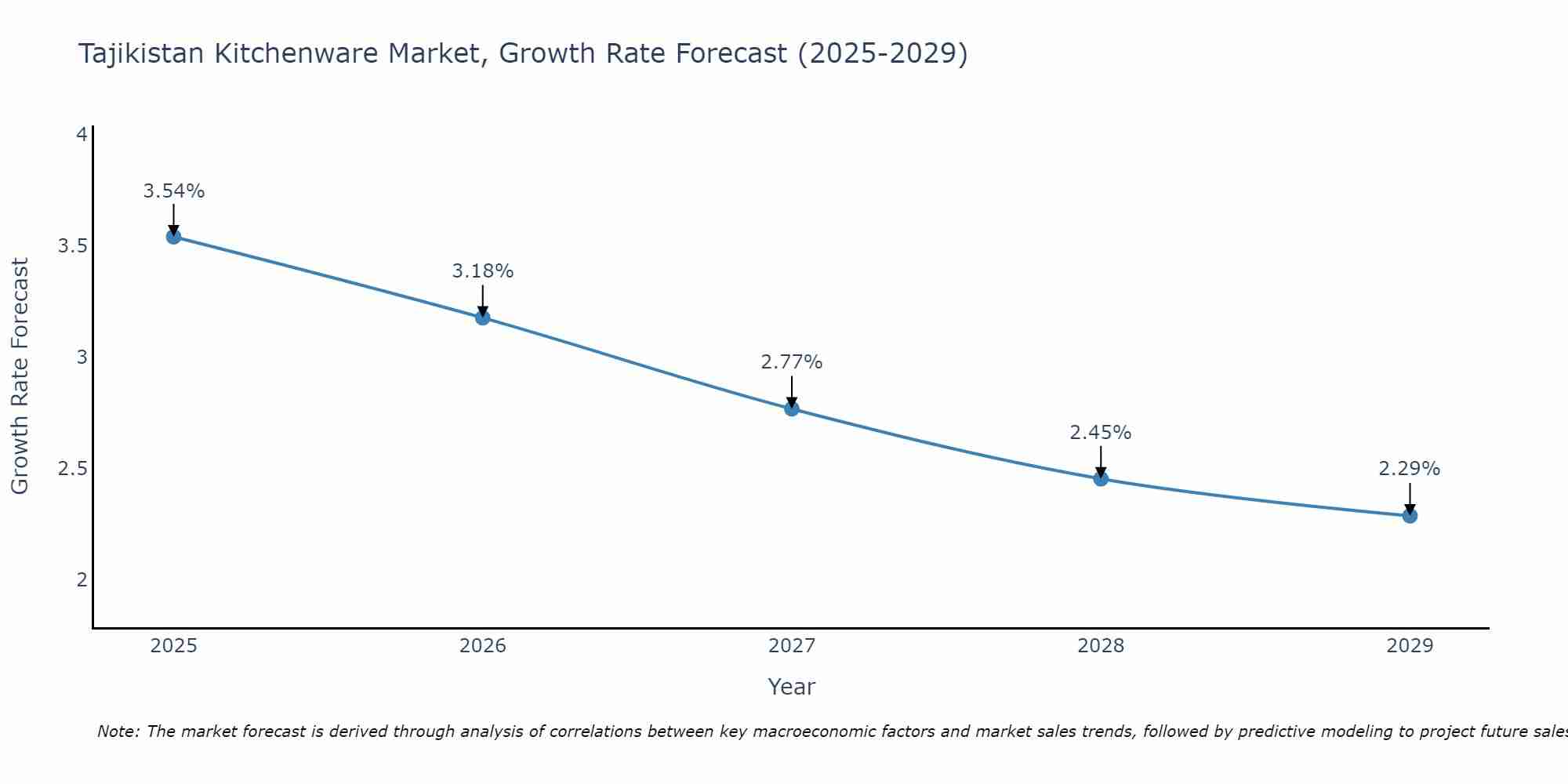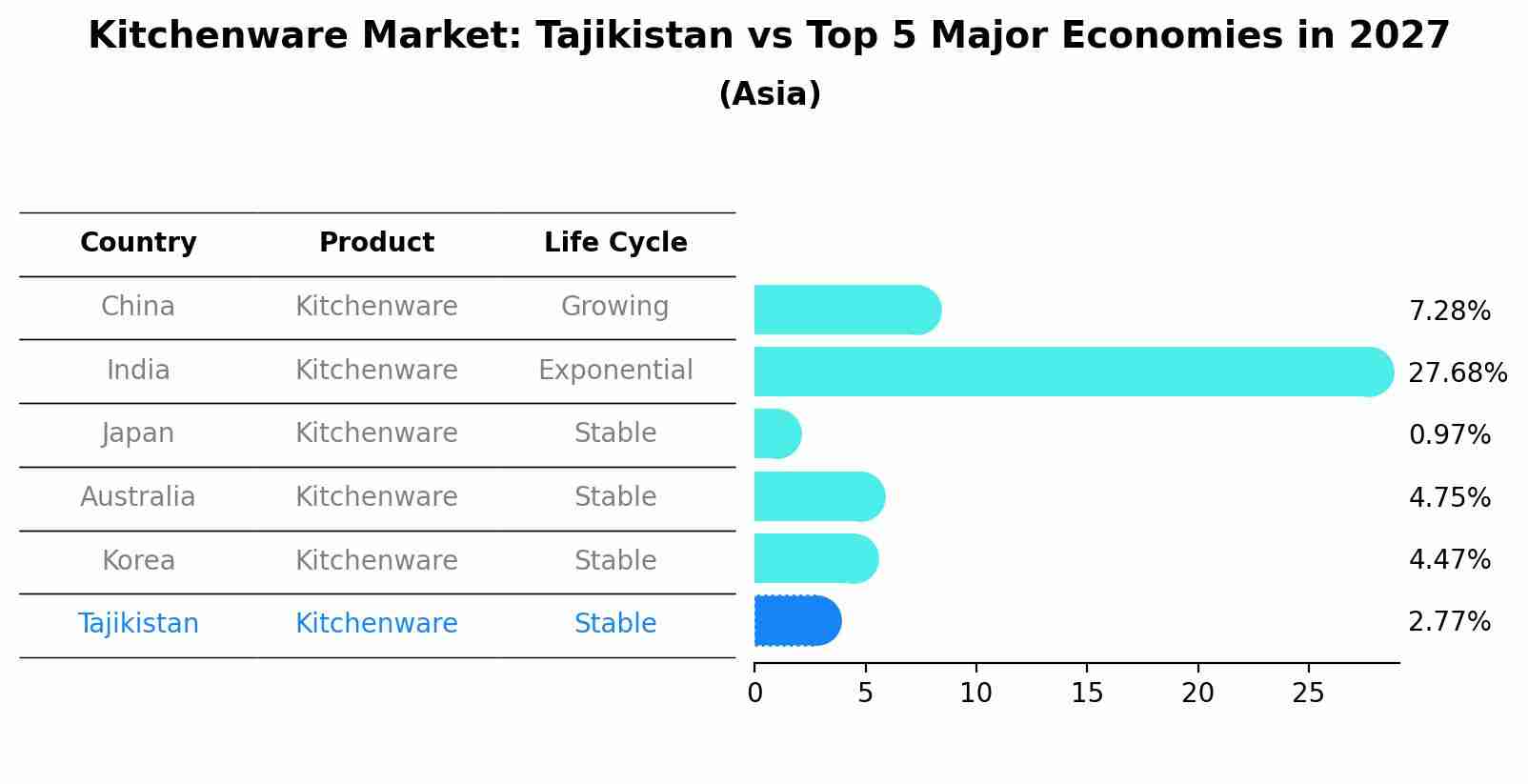Tajikistan Kitchenware Market Outlook | Forecast, Companies, Industry, Value, Size, Growth, Analysis, Revenue, COVID-19 IMPACT, Trends & Share
| Product Code: ETC377099 | Publication Date: Aug 2022 | Updated Date: Jul 2025 | Product Type: Market Research Report | |
| Publisher: 6Wresearch | Author: Dhaval Chaurasia | No. of Pages: 75 | No. of Figures: 35 | No. of Tables: 20 |
Tajikistan Kitchenware Market Size Growth Rate
The Tajikistan Kitchenware Market may undergo a gradual slowdown in growth rates between 2025 and 2029. Starting high at 3.54% in 2025, the market steadily declines to 2.29% by 2029.

Kitchenware Market: Tajikistan vs Top 5 Major Economies in 2027 (Asia)
The Kitchenware market in Tajikistan is projected to grow at a stable growth rate of 2.77% by 2027, within the Asia region led by China, along with other countries like India, Japan, Australia and South Korea, collectively shaping a dynamic and evolving market environment driven by innovation and increasing adoption of emerging technologies.

Tajikistan Kitchenware Market Synopsis
The Tajikistan kitchenware market is experiencing steady growth driven by increasing urbanization, rising disposable incomes, and a growing interest in cooking and culinary activities among consumers. Traditional kitchenware items such as copper pots, wooden utensils, and ceramic dishes remain popular, but there is a growing demand for modern kitchen gadgets and appliances. The market is characterized by a mix of local manufacturers and international brands offering a wide range of products to cater to diverse consumer preferences. Key distribution channels include specialty kitchenware stores, department stores, online retail platforms, and traditional markets. Market players are focusing on product innovation, quality, and affordability to attract and retain customers in this competitive landscape. Overall, the Tajikistan kitchenware market presents opportunities for both local and international companies looking to expand their presence in the region.
Tajikistan Kitchenware Market Trends
In the Tajikistan Kitchenware Market, there is a growing demand for modern and innovative kitchen gadgets and appliances that make cooking more convenient and efficient. Consumers are increasingly seeking eco-friendly and sustainable kitchenware options, driving the popularity of products made from natural materials such as bamboo, wood, and stainless steel. There is also a trend towards multi-functional kitchen tools that can perform multiple tasks, catering to the busy lifestyles of Tajik consumers. Additionally, with the rise of online shopping platforms, e-commerce is playing a significant role in the distribution of kitchenware products, providing consumers with a wide range of options and convenience in purchasing. Overall, the Tajikistan Kitchenware Market is witnessing a shift towards more practical, sustainable, and convenient kitchenware solutions.
Tajikistan Kitchenware Market Challenges
In the Tajikistan Kitchenware Market, several challenges are faced, including limited consumer purchasing power due to the country`s economic situation, which affects the demand for higher-priced kitchenware items. Additionally, there may be issues related to the availability and affordability of quality raw materials for manufacturing kitchenware products. Import restrictions and high tariffs on kitchenware items can also impact the market by limiting the variety of products available and increasing prices for consumers. Furthermore, competition from international brands and the presence of counterfeit products in the market pose challenges for local kitchenware manufacturers in establishing their brand reputation and attracting customers. Overall, navigating these challenges requires strategic pricing, product differentiation, and strong marketing efforts to succeed in the Tajikistan Kitchenware Market.
Tajikistan Kitchenware Market Investment Opportunities
The Tajikistan Kitchenware Market presents promising investment opportunities driven by the country`s growing urbanization and increasing disposable income. With a rising middle-class population seeking modern and convenient kitchen solutions, there is a demand for high-quality kitchenware products such as cookware, utensils, appliances, and storage containers. Investing in innovative and durable kitchenware brands that cater to the local preferences and cooking styles can be lucrative. Additionally, opportunities exist in introducing eco-friendly and sustainable kitchenware options to align with the global trend towards environmentally conscious consumer choices. Collaborating with local distributors or retailers to establish a strong presence in Tajikistan`s retail market can help investors capitalize on the growing demand for kitchenware products in the country.
Jordan Agar Market Government Policies
The Tajikistan government does not have specific policies targeted at the kitchenware market. However, the country has been making efforts to improve its overall business environment through initiatives such as streamlining regulations, reducing administrative barriers, and promoting foreign investment. This could indirectly benefit the kitchenware market by creating a more conducive environment for businesses to operate and grow. Additionally, Tajikistan`s membership in the Eurasian Economic Union (EAEU) provides opportunities for kitchenware manufacturers to access a larger market and benefit from trade agreements within the union. Overall, while there are no specific policies directly targeting the kitchenware market, the government`s broader efforts to improve the business environment and its participation in regional economic initiatives can have a positive impact on the industry.
Tajikistan Kitchenware Market Future Outlook
The Tajikistan Kitchenware Market is poised for steady growth in the coming years, driven by factors such as an increasing number of households, rising disposable incomes, and a growing trend towards modernizing kitchen spaces. Consumers are becoming more interested in cooking at home, leading to a heightened demand for kitchenware products. Additionally, the influence of global culinary trends and the popularity of cooking shows are expected to further boost market growth. Key players in the market are likely to focus on product innovation, quality, and affordability to cater to the diverse needs of consumers. E-commerce platforms are also anticipated to play a significant role in expanding market reach and accessibility. Overall, the Tajikistan Kitchenware Market presents promising opportunities for both domestic and international manufacturers and retailers.
Key Highlights of the Report:
- Tajikistan Kitchenware Market Outlook
- Market Size of Tajikistan Kitchenware Market, 2021
- Forecast of Tajikistan Kitchenware Market, 2031
- Historical Data and Forecast of Tajikistan Kitchenware Revenues & Volume for the Period 2018 - 2031
- Tajikistan Kitchenware Market Trend Evolution
- Tajikistan Kitchenware Market Drivers and Challenges
- Tajikistan Kitchenware Price Trends
- Tajikistan Kitchenware Porter's Five Forces
- Tajikistan Kitchenware Industry Life Cycle
- Historical Data and Forecast of Tajikistan Kitchenware Market Revenues & Volume By Product Type for the Period 2018 - 2031
- Historical Data and Forecast of Tajikistan Kitchenware Market Revenues & Volume By Cookware for the Period 2018 - 2031
- Historical Data and Forecast of Tajikistan Kitchenware Market Revenues & Volume By Bakeware for the Period 2018 - 2031
- Historical Data and Forecast of Tajikistan Kitchenware Market Revenues & Volume By Others for the Period 2018 - 2031
- Historical Data and Forecast of Tajikistan Kitchenware Market Revenues & Volume By End User for the Period 2018 - 2031
- Historical Data and Forecast of Tajikistan Kitchenware Market Revenues & Volume By Residential Kitchen for the Period 2018 - 2031
- Historical Data and Forecast of Tajikistan Kitchenware Market Revenues & Volume By Commercial Kitchens for the Period 2018 - 2031
- Historical Data and Forecast of Tajikistan Kitchenware Market Revenues & Volume By Sales Channel for the Period 2018 - 2031
- Historical Data and Forecast of Tajikistan Kitchenware Market Revenues & Volume By Online for the Period 2018 - 2031
- Historical Data and Forecast of Tajikistan Kitchenware Market Revenues & Volume By Offline for the Period 2018 - 2031
- Tajikistan Kitchenware Import Export Trade Statistics
- Market Opportunity Assessment By Product Type
- Market Opportunity Assessment By End User
- Market Opportunity Assessment By Sales Channel
- Tajikistan Kitchenware Top Companies Market Share
- Tajikistan Kitchenware Competitive Benchmarking By Technical and Operational Parameters
- Tajikistan Kitchenware Company Profiles
- Tajikistan Kitchenware Key Strategic Recommendations
Frequently Asked Questions About the Market Study (FAQs):
- Single User License$ 1,995
- Department License$ 2,400
- Site License$ 3,120
- Global License$ 3,795
Search
Thought Leadership and Analyst Meet
Our Clients
Related Reports
- Afghanistan Apparel Market (2026-2032) | Growth, Outlook, Industry, Segmentation, Forecast, Size, Companies, Trends, Value, Share, Analysis & Revenue
- Canada Oil and Gas Market (2026-2032) | Share, Segmentation, Value, Industry, Trends, Forecast, Analysis, Size & Revenue, Growth, Competitive Landscape, Outlook, Companies
- Germany Breakfast Food Market (2026-2032) | Industry, Share, Growth, Size, Companies, Value, Analysis, Revenue, Trends, Forecast & Outlook
- Australia Briquette Market (2025-2031) | Growth, Size, Revenue, Forecast, Analysis, Trends, Value, Share, Industry & Companies
- Vietnam System Integrator Market (2025-2031) | Size, Companies, Analysis, Industry, Value, Forecast, Growth, Trends, Revenue & Share
- ASEAN and Thailand Brain Health Supplements Market (2025-2031) | Strategy, Consumer Insights, Analysis, Investment Trends, Opportunities, Growth, Size, Share, Industry, Revenue, Segments, Value, Segmentation, Supply, Forecast, Restraints, Outlook, Competition, Drivers, Trends, Demand, Pricing Analysis, Competitive, Strategic Insights, Companies, Challenges
- ASEAN Bearings Market (2025-2031) | Strategy, Consumer Insights, Analysis, Investment Trends, Opportunities, Growth, Size, Share, Industry, Revenue, Segments, Value, Segmentation, Supply, Forecast, Restraints, Outlook, Competition, Drivers, Trends, Demand, Pricing Analysis, Competitive, Strategic Insights, Companies, Challenges
- Europe Flooring Market (2025-2031) | Outlook, Share, Industry, Trends, Forecast, Companies, Revenue, Size, Analysis, Growth & Value
- Saudi Arabia Manlift Market (2025-2031) | Outlook, Size, Growth, Trends, Companies, Industry, Revenue, Value, Share, Forecast & Analysis
- Uganda Excavator, Crane, and Wheel Loaders Market (2025-2031) | Strategy, Consumer Insights, Analysis, Investment Trends, Opportunities, Growth, Size, Share, Industry, Revenue, Segments, Value, Segmentation, Supply, Forecast, Restraints, Outlook, Competition, Drivers, Trends, Demand, Pricing Analysis, Competitive, Strategic Insights, Companies, Challenges
Industry Events and Analyst Meet
Whitepaper
- Middle East & Africa Commercial Security Market Click here to view more.
- Middle East & Africa Fire Safety Systems & Equipment Market Click here to view more.
- GCC Drone Market Click here to view more.
- Middle East Lighting Fixture Market Click here to view more.
- GCC Physical & Perimeter Security Market Click here to view more.
6WResearch In News
- Doha a strategic location for EV manufacturing hub: IPA Qatar
- Demand for luxury TVs surging in the GCC, says Samsung
- Empowering Growth: The Thriving Journey of Bangladesh’s Cable Industry
- Demand for luxury TVs surging in the GCC, says Samsung
- Video call with a traditional healer? Once unthinkable, it’s now common in South Africa
- Intelligent Buildings To Smooth GCC’s Path To Net Zero


















